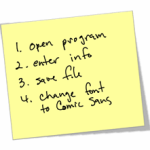It never fails. Fill a room with instructional designers and you’ll always have someone ask, ‘How do you measure your return on investment." To which I respond, "What are you? An accountant?" As the great elearning pioneer, Dr. Werner Oppelbaumer says, "If you want better ROI, hire smarter people who don’t need training."
Here’s the deal with return on investment (ROI). It’s tricky. I find that the concern is really less about ROI and more about how instructional designers can promote their value to the organization. And considering our economic climate, that’s not a bad idea.
Here are three easy ways to help you determine your ROI and promote the value you bring to your organization.
Customer Satisfaction = Success
I hired a neighborhood boy to mow my lawn. I didn’t hear the mower running, so I looked outside. He was sitting on my porch with his laptop entering data into a spreadsheet. I asked why he wasn’t mowing my lawn. He told me that he was trying to figure out the ROI.
"Look! I know the ROI. I am paying you $20 to mow my lawn. If you mow the lawn to my satisfaction, you’ll prove your value. I don’t need you to create a bunch of charts and spreadsheets."
The same goes for elearning. Assume that the customers know what they want. If you do what you agree to do and the customer’s happy, you have your ROI.
ACTION ITEMS
- Make a detailed agreement on what you’ll deliver. A common problem is that we use the same words but we don’t always mean the same thing. When working with your clients, set clear expectations and measures of success.
- Establish a timeline that is realistic. From my experience, this is an area that trips up a lot of projects. The timeline is fuzzy and with that so are expectations. Fuzzy expectations lead to a less than stellar end result, which ultimately leads to an unhappy customer. Assume that when all is said and done, you’re to blame. So it’s in your best interest to set a clear timeline and work to meet it or beat it.
- Do a post project debrief with your client to measure their level of satisfaction. If you wait until the end of the year, their enthusiasm will wane and they’ll be bombarded by other people looking for end-of-year feedback. I make it a habit to follow up right after the project is complete. I want to know what went well and where I can make improvements for the next project.
Align the Course Outcome to a Measurable Goal
The challenge for a lot of courses is that they aren’t tied to real performance goals. They might have value to the organization, but it’s not always clear how. So you end up with a lot of information-dumping and no focused performance improvements. Your job is to get the course focused on performance.
How do you measure the ROI of a new hire training course? If it’s an information dump, that’s hard. However, if you tie the information to a performance goal then you have a metric to hang your hat on. For example, new employees need more hand holding for initial IT support. Suppose your course teaches them how to self-serve their IT issues. You can measure a drop in call frequency or IT help requests. That is a measurable improvement and shows the impact of your course.
Ideally your course is built around a real performance goal. If you’re not quite sure what that is, help the customer sort through their expectations. The key question here is, "How will you know you’re successful?" You’re looking for some metric that they use as proof of success. Then you want to build your course to change that number.
ACTION ITEMS
- Find a metric you can use. There’s always something. Even if it’s taking a 30 minute course down to 15 minutes. That’s a 50% decrease in time. Multiply that over 10 people and you’ve saved 150 minutes. :)
- Make sure the metric is meaningful. As you can see by the example above, percentages can be deceiving. No one cares if you save 150 minutes. Besides, you have to save a lot more than that if you want your CEO to get his bonus.
- Learn to be a performance consultant so you’re better able to help your clients focus on the right things. Robinson’s book, Performance Consulting, is a good place to start.
Lower Your Production Costs
Sometimes you have no access to the metrics that measure success. And even if you did, trying to prove your ROI becomes too costly. Instead of focusing on what you can’t control, focus on what you can, such as your production time and the resources needed to create a course.
I’ll benchmark my courses. For example, a simple elearning course can cost anywhere from $5,000 to $15,000 depending on what you do. I just split the difference and set my baseline cost at $8,000. My goal is to bring my simple courses in under that cost. It’s not a completely accurate number but it is a good place to start. Your ultimate goal is to cost less than your competition. In these tough economic times, you want to demonstrate that you are a cost-effective solution to meet the organization’s needs.
ACTION ITEMS
- Find out what your courses cost. You don’t need to be an accountant. Ball park the figures. If someone challenges your numbers, let them do the math for you. The main goal is to know what you cost the organization. Without that number you won’t be able to prove your value.
- Benchmark your courses. Low-end courses are usually less than $10,000. Many of the high-end courses can costs hundreds of thousands. It makes sense to figure out where you fit in comparison. In tough times, training is usually an early casualty. You want to demonstrate that you are a cost-effective solution.
- Cut production costs. Make one of your performance goals to cut your production costs by 20%. You’ll save money and probably find ways to become more efficient as a team. In an earlier post, I outlined my production strategy. I start with rapid elearning software and move up from there. It saves time and money and frees up my more expensive multimedia programmers to do what the software can’t.
When it comes to return on investment, you have two goals. You want to bring value to the organization and you want show that YOU bring value to the organization. You can do this by meeting your customer’s expectations, aligning your projects to real measurable objectives, and controlling your production costs.
I look forward to your feedback and comments. Feel free to share them by clicking on the comments sections.
Events
Free E-Learning Resources















0
comments